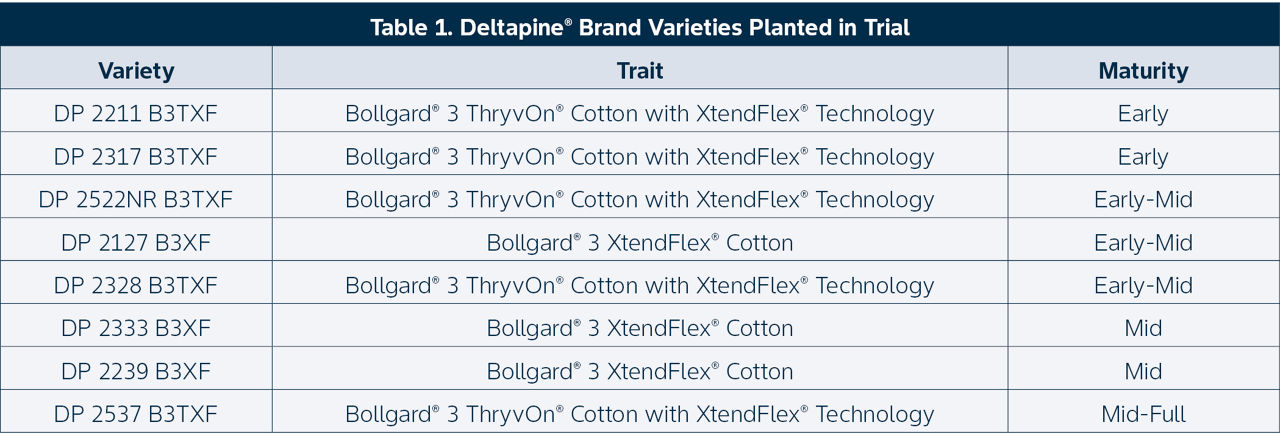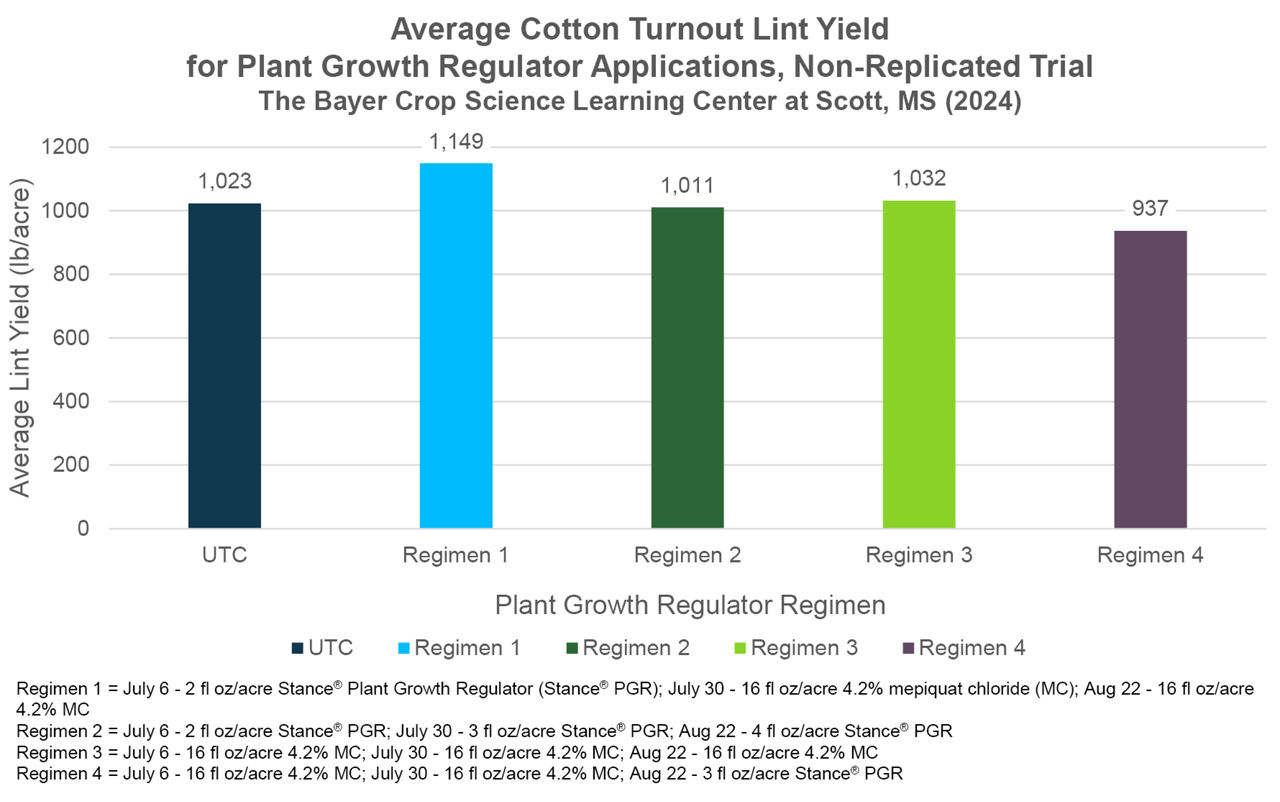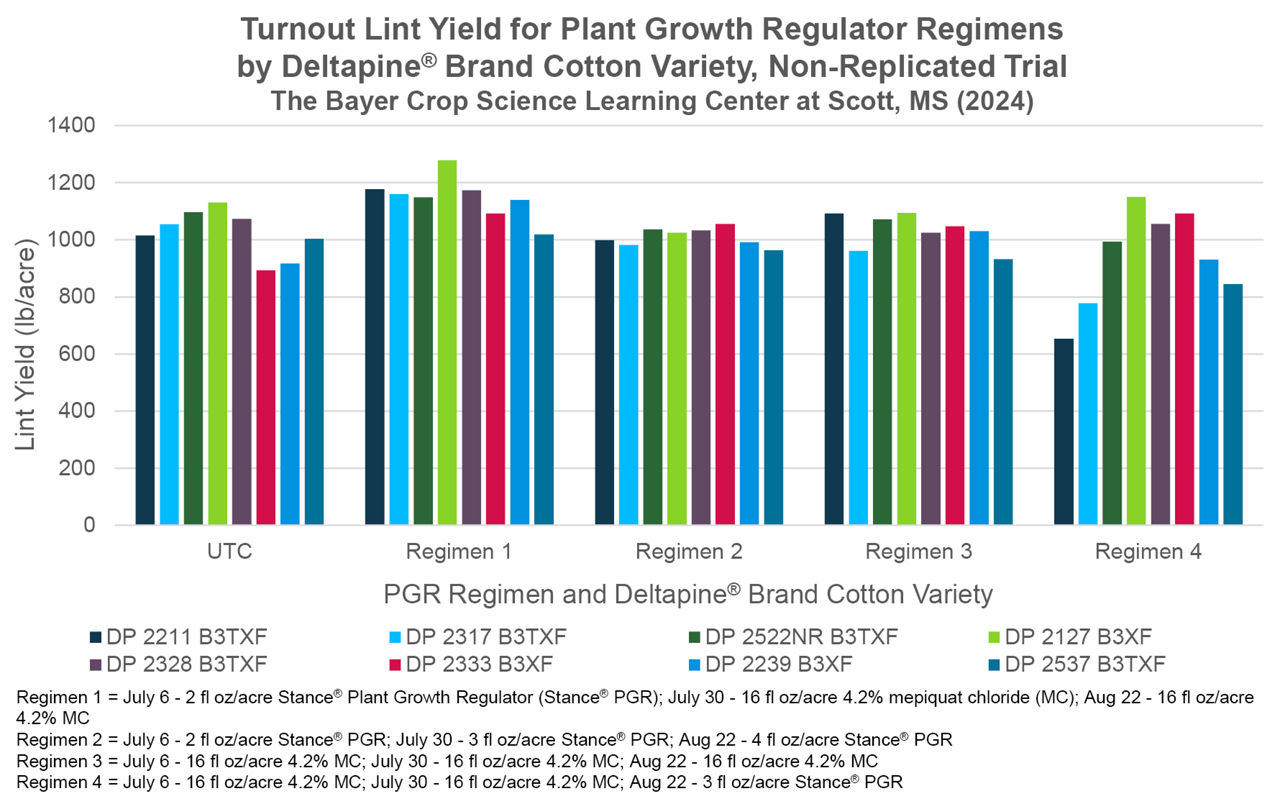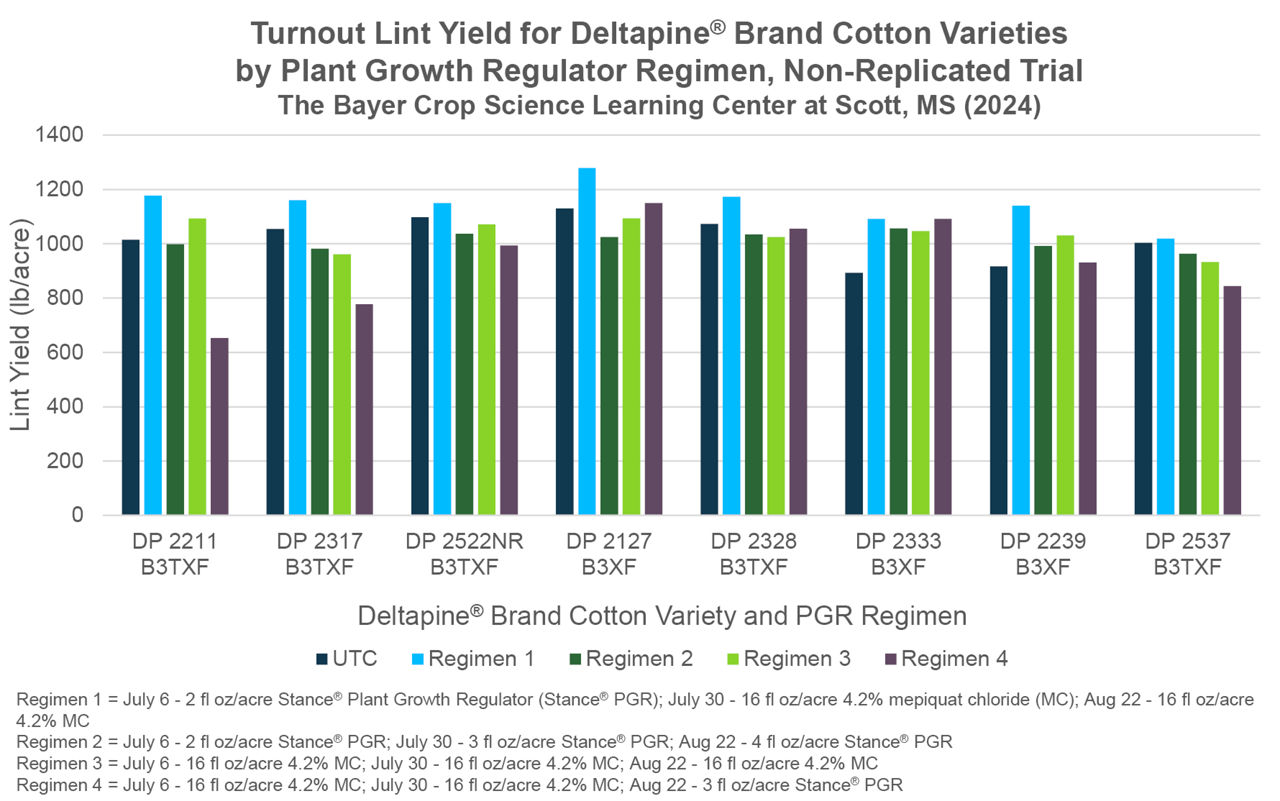Evaluations of Stance® Plant Growth Regulator on Deltapine® Brand Cotton Varieties
February 25, 2025
Click on a tab below to see data collected each year for this study
TRIAL OBJECTIVE
- The use of a plant growth regulator (PGR) can help optimize cotton varietal potential. PGR use is highly dynamic and must be customized for each growth case during a season.
- Stance® Plant Growth Regulator is a Bayer Crop Science product containing the active ingredients mepiquat chloride and cyclanilide, which offers a growth control option for cotton growers. This combination typically offers crop safety when used early at lower rates and powerful growth control in late-season situations where more powerful control is needed.
- The objective of this trial was to help answer questions about the best way to use Stance® Plant Growth Regulator with Deltapine® brand cotton varieties. The questions include whether to use the PGR early at low rates, later with higher rates, or at both times.
RESEARCH SITE DETAILS

- Plant growth regulator application dates
- July 6
- July 30
- August 22
- Plant growth regulator products applied
- Stance® Plant Growth Regulator
- Generic 4.2% mepiquat chloride
- Application regimens
- Untreated Check (UTC) – No PGR Applied
- Regimen 1
- 7/6/2024 – 2 fl oz/acre of Stance® Plant Growth Regulator
- 7/30/2024 – 16 fl oz/acre of 4.2% mepiquat chloride
- 8/22/2024 – 16 fl oz/acre of 4.2% mepiquat chloride
- Regimen 2
- 7/6/2024 – 2 fl oz/acre of Stance® Plant Growth Regulator
- 7/30/2024 – 3 fl oz/acre of Stance® Plant Growth Regulator
- 8/22/2024 – 4 fl oz/acre of Stance® Plant Growth Regulator
- Regimen 3
- 7/6/2024 – 16 fl oz/acre 4.2% mepiquat chloride
- 7/30/2024 – 16 fl oz/acre 4.2% mepiquat chloride
- 8/22/2024 – 16 fl oz/acre 4.2% mepiquat chloride
- Regimen 4
- 7/6/2024 – 16 fl oz/acre 4.2% mepiquat chloride
- 7/30/2024 – 16 fl oz/acre 4.2% mepiquat chloride
- 8/22/2024 – 3 fl oz/acre of Stance® Plant Growth Regulator
- All field work, tillage, and herbicides were per local standards.
- Single-replication strip-plot with each regimen consisting of 12 rows which were each 1,000 feet long (about 1.0 acre/regimen).
- Center 6 rows were machine harvested for yield estimation (about 0.4 acre/regimen).
- Data on field observations for growth characteristics/management decisions during the season were collected as follows:
- Plant heights not taken due to time limitations during the late season but typical responses were observed.
- Representative site turnouts (from Heaven Cut Variety Evaluations) used to estimate lint yields.
- Data on field observations for growth characteristics/management decisions during the season were collected as follows:
- Deltapine® brand cotton varieties planted are listed in Table 1.
Table 1. Deltapine® Brand Varieties Planted in Trial.

- Additional plot information:
- This location would be characterized as a difficult early season environment followed by adequate growth conditions during the mid and late season.
- Growth rates/observations were indicative of conditions where lower intensity growth control options would typically be used early season, followed by increasing rates/intensity during the mid/late season.
UNDERSTANDING THE RESULTS
- The highest lint yields and moderate growth control responses were recorded in the treatments applying Stance® Plant Growth Regulator at 2 fl oz/acre on July 6 followed by 16 fl oz/acre rates of 4.2% mepiquat chloride applications on July 30 and August 22 (Figure 1, Regimen 1). This would be expected in a growth environment where plant development was slow and/or delayed by early season conditions.
- Varietal background has an influence on potential PGR response:
- Deltapine® brand DP 2211 B3TXF and Deltapine® brand DP 2317 B3TXF—which have the most determinate genetics—were lower yielding in the most aggressive treatment combination (Figure 2, Regimen 4).
- Deltapine® brand DP 2127 B3XF, Deltapine® brand DP 2333 B3XF, and Deltapine® brand DP 2328 B3TXF—which are more indeterminate varieties—were not severely affected by the aggressive treatments (Figure 2, Regimen 4). Their corresponding yields were marginally improved by more aggressive treatments.
- Figure 3 shows individual product performance by treatment.



KEY LEARNINGS
- Stance® Plant Growth Regulator offers an option for PGR use in difficult early season growth conditions, allowing growers to use a PGR to react to the crop as it develops.
- This data represents one environment, year, and location with several varieties included as examples. In other conditions, recommendations and product usage would likely shift in several ways.
- Please contact your Bayer or Deltapine® brand representative for more information.
No dicamba may be used in-crop with seed with Roundup Ready® Xtend Technology, unless and until approved or specifically permitted, and no dicamba formulations are currently registered for such use in the 2025 season. Please follow www.roundupreadyxtend.com/pages/xtendimax-updates.aspx for status updates. Dicamba may harm crops that are not tolerant to dicamba.
1414_218700